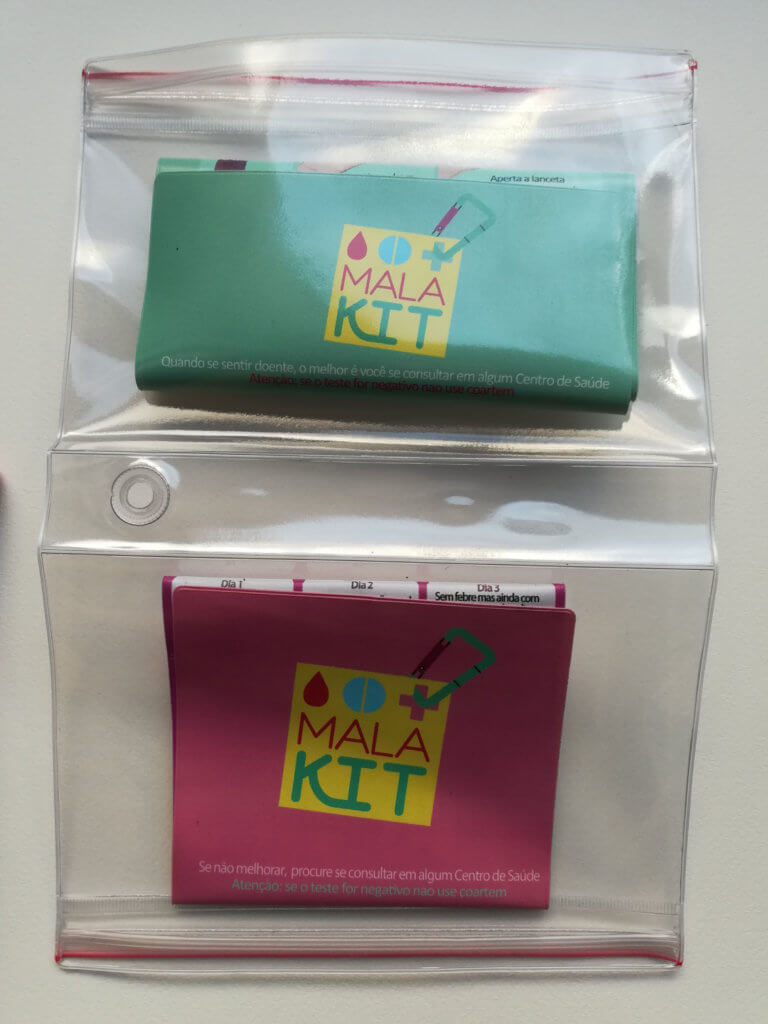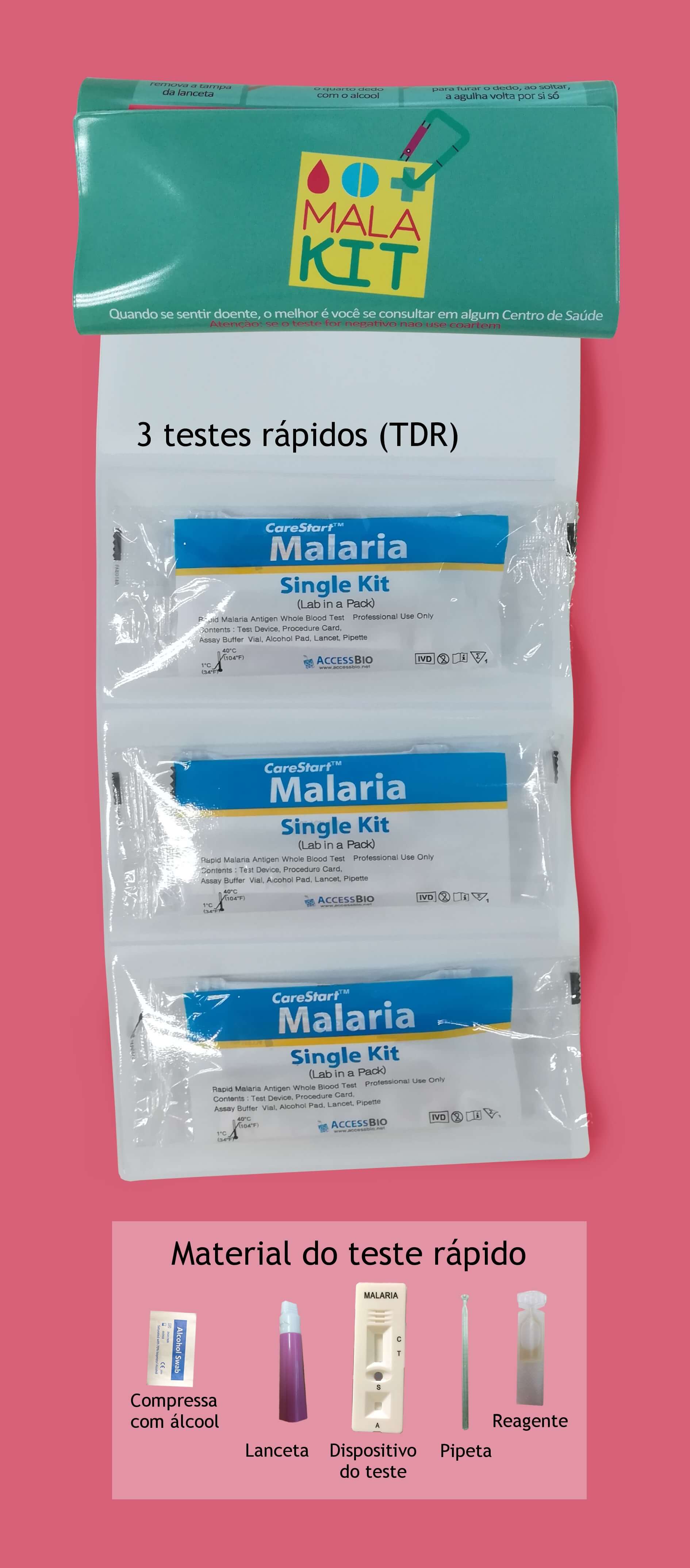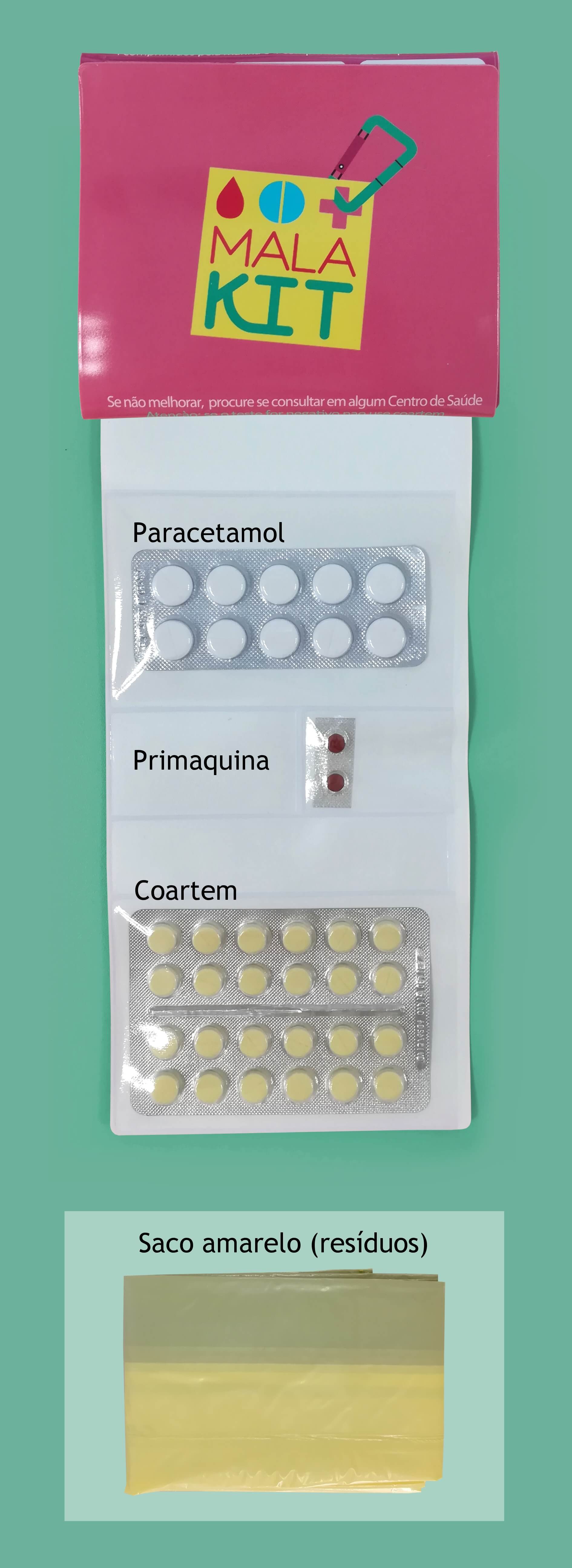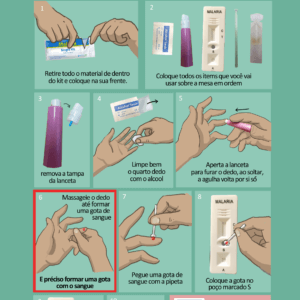What is a Malakit?

The unfolded kit
Malakit is a transparent plastic pouch divided into two pockets:
- In the first pocket, a holder containing three rapid diagnostic tests (RDT).
- In the second one, a small waste bag and a holder containing medications :
- the full malaria treatment course:
- 1 single dose of primaquine = 1 strip of 2 tablets (7,5 mg each)
- full adult course of an artemether 20 mg/lumefantrine 120 mg combination drug: Coartem® = 1 strip of 24 tablets
- Paracetamol (=acetaminophen) = 1 strip of 10 tablets (500 mg)
- the full malaria treatment course:
The logo of the project (created by Audrey Techer) and the illustrated instructions for performing a self-diagnostic test and on how to take the medication are printed directly on the holder.
The Malakit is handed out together with a long-lasting impregnated net (LLIN) for hammocks.
Why a plastic pouch?
The pouch was designed to fit the gold miners’ habits:
They are waterproof, the size of a wallet (20 cm X 15 cm/ 7,9 X 5,9 inches), with a hole to insert a carabiner clip for easy transportation and illustrated instructions in Portuguese printed directly on the plastic holders.

the RDTs pocket
What type of rapid diagnostic test is it?
It is the CareStart™ Malaria pLDH (pan), made by ACCESSBIO.
All testing components are included in one individual single-use package.
It is a non-specific test which can diagnose all four types of malaria parasite (called Plasmodium): falciparum, vivax, ovale, and malariae.
The RDT was chosen according to the following criteria:
- ease of use: result is either negative or positive (one band or two bands) so the test can be used by lay people and even by people with poor literacy;
- the individual packaging of the test;
- stability at temperatures above 35 °C;
- a shelf life of at least 12 months;
- the CE (European Community) label and WHO pre-qualification.
Why three diagnostic tests?
Three tests are included in order to take into account different situations before a miner returns to a distribution site for new supplies: having several episodes of malaria symptoms, cases of invalid tests, and giving test to someone else.
Why provide artemisinin combination therapy (ACT) and a single-dose primaquine (15 mg) treatment ?

The medication pocket
ACT
The selected ACT, artemether 20 mg/lumefantrine 120 mg, is the treatment recommended by the respective health authorities in the three countries involved in the project, according to WHO recommendations.
It is effective on acute cases linked to P. falciparum and P. vivax, the two most frequent malaria parasite species circulating in French Guiana. It will therefore reduce the overall morbidity and mortality of malaria.
However, since the test does not enable detection of P. vivax, the individual will not benefit from curative treatment of hypnozoites by primaquine (14-day treatment) after screening for G6PD deficiency. Instead, kit users will be instructed that, in the event of a new malaria episode a month or so after the first attack, they should go to a health center to be checked and eventually treated for P. vivax relapse.
The general objective of this project is to avoid the emergence of resistance in P. falciparum, the deadliest pathogen with high level risk for the emergence of resistance. Therefore, the study’s objectives are not hindered if relapses of P. vivax do not decrease.
Primaquine
The single dose of primaquine is not necessary to cure cases of malaria but has altruistic purposes. It is recommended in addition to treatment regimens as a gametocytocid. In other words, by killing the parasite form in the blood taken up by the mosquitoes, it has great potential for reducing the transmission of malaria.
What is paracetamol for?
Paracetamol is for pain and fever relief, whatever the result of the test may be. The idea is that in case of a negative test, the person is not left without any alternative to taking antimalarial medication.
How were the training tools created?

First drawing prototype
Mandatory training is provided when the kits are distributed. However, even if miners demonstrate their ability to perform the test correctly during distribution, it must be ensured that they will remember all the steps if they eventually need to perform the test later.
That is why the kits were designed with illustrated explanations thanks to Laure Garancher and the non-profit organization The Ink Link. However, it was difficult for designers to perceive the level of understanding of this population, which often has a limited reading level. It was therefore proposed that a participatory approach be used to develop an illustrated treatment protocol together with these miners.
We thus defined an initial set of instructions describing each of the necessary steps to carrying out a rapid diagnostic test, as we (health professionals) perceived them. We presented these instructions to the gold miners and assessed their performance.
Whenever a step was not clear enough, we redrew the instructions to add more information. Some steps that may seem obvious to healthcare professionals required clarification for the gold miners.

Final illustrated instructions
We reproduced the protocol repeatedly, each time presenting the “improved” instructions, until five people could carry out the entire test without committing the slightest error.
This participatory illustrated approach enabled the development of an instruction manual that is totally tailored to the target population.
Experience has shown that without this work with the gold miners, it would have been virtually impossible to clearly define an effective protocol. The method is simple and quick to set up. Moreover, the presence of an illustrator was greatly appreciated, as it demonstrated the commitment of the project stakeholders to explicitly meet the expectations of the beneficiaries.
We believe that comics can facilitate dialogue between communities, as well as being an efficient communication and advocacy tool. (TheInkLink)